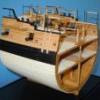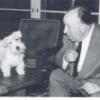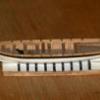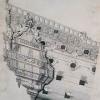MORE HANDBOOKS ARE ON THEIR WAY! We will let you know when they get here.
×
-
Posts
2,438 -
Joined
-
Last visited
Reputation Activity
-
 dvm27 reacted to Mike Dowling in Fokker Dr.I by Mike Dowling - FINISHED - Artesania Latina
dvm27 reacted to Mike Dowling in Fokker Dr.I by Mike Dowling - FINISHED - Artesania Latina
The covering so far just to give an idea
-
 dvm27 reacted to druxey in HMS Winchelsea 1764 by Stuntflyer (Mike) - FINISHED - 1/4" scale
dvm27 reacted to druxey in HMS Winchelsea 1764 by Stuntflyer (Mike) - FINISHED - 1/4" scale
I hate to mention this and hope it's an artifact of photography, but the hull appears to be developing a slight twist (check the last stern-on photo). If so and I'm right, it should be correctable at this point. Nice, clean work though.
-
 dvm27 reacted to KenW in HMS Winchelsea 1764 by Stuntflyer (Mike) - FINISHED - 1/4" scale
dvm27 reacted to KenW in HMS Winchelsea 1764 by Stuntflyer (Mike) - FINISHED - 1/4" scale
Mike: You're doing a great job. I think the problem Dave sees is that in the photo the vertical is not straight up-and-down.
And the bow, because it is farther away, seems less vertical than the stern.
I hope I'm right.
-
 dvm27 reacted to Stuntflyer in HMS Winchelsea 1764 by Stuntflyer (Mike) - FINISHED - 1/4" scale
dvm27 reacted to Stuntflyer in HMS Winchelsea 1764 by Stuntflyer (Mike) - FINISHED - 1/4" scale
Well, druxey, you are absolutely correct! I spotted it too while working on the stern frames. Steps are being taken now to fix this. I should have it done in a few days. Hopefully!
Mike
-
 dvm27 got a reaction from FrankWouts in HMS Winchelsea 1764 by Stuntflyer (Mike) - FINISHED - 1/4" scale
dvm27 got a reaction from FrankWouts in HMS Winchelsea 1764 by Stuntflyer (Mike) - FINISHED - 1/4" scale
Looking very good Mike. That slotted bulkhead (#29) shows this to be a very well thought out and designed kit! It address all the usual problems associated with raising the counter timbers.
-
 dvm27 got a reaction from wyz in HMS Winchelsea 1764 by Stuntflyer (Mike) - FINISHED - 1/4" scale
dvm27 got a reaction from wyz in HMS Winchelsea 1764 by Stuntflyer (Mike) - FINISHED - 1/4" scale
Looking very good Mike. That slotted bulkhead (#29) shows this to be a very well thought out and designed kit! It address all the usual problems associated with raising the counter timbers.
-
 dvm27 reacted to DocBlake in Royal Navy Ship of the Line Cross-Section by DocBlake - FINISHED - based on Mamoli's "Constitution" - 1:93 scale
dvm27 reacted to DocBlake in Royal Navy Ship of the Line Cross-Section by DocBlake - FINISHED - based on Mamoli's "Constitution" - 1:93 scale
I installed the beams for the gun deck and finished the central planking. I need to install the bilge pumps before I complete the decking. The pump handles and discharge ports are pretty simple. The parts are metal, and I'll prime them with flat black auto primer and paint the discharge area a brass color with flat white tops to simulate white canvas. The pipes leading down through the orlop deck into the well are a little different. The enclosed photo of the Constitution shows they were black pipe, fitted with a brass or bronze cap as they neared the pump mechanism. I think I'l just use flat black stained dowels to simulate them. Any thoughts?
-
 dvm27 reacted to aviaamator in La Jacinthe 1825 by aviaamator - 1:20 - schooner
dvm27 reacted to aviaamator in La Jacinthe 1825 by aviaamator - 1:20 - schooner
For some time he was not engaged in the construction of the model, because it is impossible to remain indifferent when people die in the fire, small children... There are no more words, only work helps to distract a little from this tragedy. I wish everyone good health!!!
-
 dvm27 got a reaction from Martin W in HMS Winchelsea 1764 by Stuntflyer (Mike) - FINISHED - 1/4" scale
dvm27 got a reaction from Martin W in HMS Winchelsea 1764 by Stuntflyer (Mike) - FINISHED - 1/4" scale
Looking very good Mike. That slotted bulkhead (#29) shows this to be a very well thought out and designed kit! It address all the usual problems associated with raising the counter timbers.
-
 dvm27 got a reaction from Stuntflyer in HMS Winchelsea 1764 by Stuntflyer (Mike) - FINISHED - 1/4" scale
dvm27 got a reaction from Stuntflyer in HMS Winchelsea 1764 by Stuntflyer (Mike) - FINISHED - 1/4" scale
Looking very good Mike. That slotted bulkhead (#29) shows this to be a very well thought out and designed kit! It address all the usual problems associated with raising the counter timbers.
-
 dvm27 got a reaction from Canute in HMS Winchelsea 1764 by Stuntflyer (Mike) - FINISHED - 1/4" scale
dvm27 got a reaction from Canute in HMS Winchelsea 1764 by Stuntflyer (Mike) - FINISHED - 1/4" scale
Looking very good Mike. That slotted bulkhead (#29) shows this to be a very well thought out and designed kit! It address all the usual problems associated with raising the counter timbers.
-
 dvm27 got a reaction from Old Collingwood in HMS Winchelsea 1764 by Stuntflyer (Mike) - FINISHED - 1/4" scale
dvm27 got a reaction from Old Collingwood in HMS Winchelsea 1764 by Stuntflyer (Mike) - FINISHED - 1/4" scale
Looking very good Mike. That slotted bulkhead (#29) shows this to be a very well thought out and designed kit! It address all the usual problems associated with raising the counter timbers.
-
 dvm27 got a reaction from Hubac's Historian in HMS Winchelsea 1764 by Stuntflyer (Mike) - FINISHED - 1/4" scale
dvm27 got a reaction from Hubac's Historian in HMS Winchelsea 1764 by Stuntflyer (Mike) - FINISHED - 1/4" scale
Looking very good Mike. That slotted bulkhead (#29) shows this to be a very well thought out and designed kit! It address all the usual problems associated with raising the counter timbers.
-
 dvm27 reacted to druxey in HMS Bellona 1760 by SJSoane - Scale 1:64 - English 74-gun - as designed
dvm27 reacted to druxey in HMS Bellona 1760 by SJSoane - Scale 1:64 - English 74-gun - as designed
Nice sketches, as others have already noted, Mark.
That problematic last piece was apparently shaped rather than bent in the shipyard, so you are in good company. Carve the inner surface first, fit the joint, attach, then carve/file/sand the outer surface to shape, would be a good strategy. Good luck with it!
-
 dvm27 reacted to shipmodel in SS Michelangelo 1962 by shipmodel - FINISHED - 1/350 scale
dvm27 reacted to shipmodel in SS Michelangelo 1962 by shipmodel - FINISHED - 1/350 scale
Hi again to all –
Thanks for all the support and compliments. I am glad that you are enjoying this voyage.
With the pools finished, I turned to the next detailed subassemblies, the funnels. As you can see, they are some of the most visually important elements of the ship.
In profile they dominate the center of the ship, especially because of the dark caps that contrast with the rest of the white colors of the ship. In the enlargement you can see that there are three major components to the funnels – the latticework cages, a central tube, and those smoke protection caps.
The plans show that the two funnel cages, tubes and caps are identical, but the forward funnel has a pierced skirt that lifts it higher than the aft one, requiring a taller base for the funnel tube. The caps angle forward about 2.5 degrees and have low railings on top.
This color photo reveals that the forward funnel has a ladder up the front face of the octagonal base and up the forward line of the central pillar. Painted bands with the red and green colors of the Italian Line circle the cage just under the cap. Two foghorns are mounted just above the reinforcing ring about halfway up the cage.
From underneath you can see the bars that connect the cage to the pillar from each six-way intersection at the level of the reinforcing ring. Also, the central pillar is not a simple tube, but has a number of smaller tubes circling it, all confined by a number of wires. Between the foghorns is a grating platform, probably to service the horns.
These details are all seen clearly in the photo from the cover of the New York Times magazine section. It also shows that the bottom skirt is supported on the back of each vertical upright by a triangular buttress. The details are, of course, the only things that interest me in the photograph. . . .
As reported earlier in the build log, the cages were 3-D printed by Hexnut. The first set was just a bit small. My bad, not his. I worked out the proper dimensions and he redid the design and had them printed by Shapeways. They were even more perfect than the first set. Thanks again, Bob.
I started construction with the central pillars, and with the bases first. From the photographs it is clear that they are octagonal with sloped sides. The aft one is 6mm tall, the forward one 12mm. To make the aft octagon I cut a hardwood piece into a square on the Preac saw. Using simple geometry I located the center, then marked out a circle just to the edge of the square. Using a 45 degree square I drew lines at each corner tangent to the circle. This defined the octagon (a). I measured the slope from the plans and drew a smaller concentric circle. Using 90 degree and 45 degree squares a concentric octagon was marked out (b). To keep everything clear I darkened the waste wood (c). Then it was easy to cut off the corners on the band saw and to slope the sides to the top line using a disc sander. The forward one was made in a similar fashion, just taller.
The central pillar began with a brass tube 10mm in diameter set into a shallow drilled hole in the center of the base. Three rings of 0.01”x 0.04” strip were wrapped around the tube and secured. The location of the middle one had to match the reinforcing ring on the cage, which is why the base had to be built first (a). A photoetched ladder was cut and fitted to the front center of the tube before 15 rods of 0.035” were set up and glued to the three rings around the tube (b). Solid rings top and bottom and an interrupted one in the center secured the vertical rods, and four restraining wires further detailed the pillar (c).
This construction fit nicely inside the cage and needed only a little tweaking. Once I was happy with it, both the pillar and the cage were given their first coat of spray primer.
The skirt for the forward funnel began with a paper pattern. Between the oval shape and the changing flare there was no way that I could predict what it would look like. Small pieces of translucent tape were applied to the bottom of the cage and flared as needed. The inner line was marked at the lower edge of the cage, and the center of the front was marked with a cross. The tape was carefully stripped off and applied to a piece of card. The inner line was cut and tested against the cage. Once I was happy with it, a line was drawn defining a strip 6.5mm wide. It forms a very strange shape (a). This was transferred to 0.03” sheet and cut out, fitted and glued to the cage. The bottom edge was lightly sanded so it sat flat and firm (b).
With the solid skirt in place the 16 windows were marked out with 1mm rings top and bottom and verticals coming down from each lower joint on the cage. Each opening was first drilled out in the center, then carefully whittled close to the lines with a fresh blade in my knife. Needle files finished the work (a). Oversized tapered pieces of 0.03” strip were glued to the verticals with white glue, then the joint was strengthened with cyano on each side. When everything was dry the excess was cut off. You can see three finished buttresses with three more being installed (b). Once they were all in, the bottom of the skirt was again gently sanded so everything would sit flat.
I knew that I wanted to include the rods from the cage to the pillar if I could. Gentle experimentation convinced me that the cages were not strong enough to survive the stresses of drilling holes at each 6-way intersection. I therefore added a reinforcing strip of 0.02” x 0.04” behind the ring. With it in place and after being primed, the color bands were carefully painted on (a). So here are the two components of each funnel as they will fit to each other. The bars cannot be installed with them not fixed to each other, and will have to wait until they are mounted to the cap (b).
Next, the caps will be constructed and the funnels assembled.
Be well.
Dan
-
 dvm27 reacted to DocBlake in Generic Sharpie by DocBlake
dvm27 reacted to DocBlake in Generic Sharpie by DocBlake
The plan template is glued to the build board. Building jig #1 had templates glued to the top and side after being ripped to width. The next step is to cut out the slots where the 1/8" thick plywood station templates sit. They will be used to define the chines and the keelson. Once cut out, the jig will be trimmed to length and carefully screwed to the build board.
-
 dvm27 reacted to Gaetan Bordeleau in 74-gun ship by Gaetan Bordeleau - 1:24
dvm27 reacted to Gaetan Bordeleau in 74-gun ship by Gaetan Bordeleau - 1:24
My experiences are not finished yet, I pushed the limit by adding two 2X extender in the spotting scope assembly.
Installation of the first molding
The position of the top frames will be final. All the frames are now glued together as a whole, even if before, many were not glued together by the top spacers. I think I gave the frames enough time to stabilize, with also the stability of the humidity before the spring begins, not really began here, it was minus 15 this morning.
The blade profile exist simply because I did it few years ago. The idea for the holder is that it can be hold by both hand. It runs on the top of the plank as in second picture. In fact, I used my biggest vice on the height table. The vice is a secure method to hold the plank. When the molding is done, then the width is cut on the saw.
Before the installation of the moldings, a batten was installed as a guide as we have in many other modeler, just like Mark. Even if the line was already traced, the beauty of this batten is that it can be adjusted more precisely before simply because the batten is not glued. Also the batten is in one piece only to assure a smoother curve. Another advantage, the curve is easier to follow with the molding because it can rest on a existing curve well fixed with clamps. The laser line is also very helpfull it helps to see the regularity of the curve, ad ecerything can be corrected before all is glued. It is much more difficult to install the molding with the correct curve without a guide.
-
 dvm27 reacted to Maury S in Anchor Hoy c. 1825 by Maury S - FINISHED - 1:48 - Harbor craft - POF
dvm27 reacted to Maury S in Anchor Hoy c. 1825 by Maury S - FINISHED - 1:48 - Harbor craft - POF
When I'm not coiling lines, I'm working on the case.
Off to buy the "Museum Glass" now that I've got the final dimensions.
Maury
-
 dvm27 reacted to Erebus and Terror in HMS Terror by Erebus and Terror - FINISHED - Scale 1:48 - POB - as fitted for polar service in 1845
dvm27 reacted to Erebus and Terror in HMS Terror by Erebus and Terror - FINISHED - Scale 1:48 - POB - as fitted for polar service in 1845
Hello Everyone,
An encouraging update. OcCre just wrote and have admitted that they used my designs/research to create their model - and they are willing to acknowledge and recognize that in some way.
I think it's a good sign. The next step will be for me to request copies of their packaging, plans, and instructions that will go with the kit to see exactly what I'm dealing with. Recognition is good, though I admit this isn't the kit I would have made. It's actually a relatively decent kit for what it is, though.
I'll keep posting updates, but I admit I didn't expect this response, and I'm cautiously optimistic.
Cheers,
E&T
-
 dvm27 reacted to Jeronimo in Chebece 1750 by Jeronimo - FINISHED
dvm27 reacted to Jeronimo in Chebece 1750 by Jeronimo - FINISHED
Hello friends.
Production of the cannons by the tin process.
Karl
P a r t 1 5
-
 dvm27 reacted to wefalck in Young America 1853 by EdT - FINISHED - extreme clipper
dvm27 reacted to wefalck in Young America 1853 by EdT - FINISHED - extreme clipper
if it had to be really fast: every sailor had a knife in a sheath on his back so that it could be reached by both hands ...
-
 dvm27 reacted to EdT in Young America 1853 by EdT - FINISHED - extreme clipper
dvm27 reacted to EdT in Young America 1853 by EdT - FINISHED - extreme clipper
Young America - extreme clipper 1853
Part 279 – Main Yard Stuns'l Booms
The main yard was fitted with the two topmast studdingsail booms. These supporedt the clews of the topmast studdingsails as well as the lower studdingsail yards that weresuspended from the ends of each when these sails were set. The booms were 42 feet long and 8 3/8" in diameter over their center sections. They taper to about 5 ¾" at the ends. All the drawing dimensions are expressed in full size decimals to permit easy conversion based on scale. The 1/72 converted sizes may be seen penciled on the drawing in the first picture.
The picture shows a finished boom and the "first trim" of the second – a squared length of Castello marked with centerlines and the two points at the ends pf the straight section. The boom is grooved for jewel blocks at the outboard end and drilled for a lashing at the inboard end. The inner hole was also used to fix a temporary tackle for hauling out the boom. The next picture shows a finished boom set in the boom irons in the retracted position.
The booms were shaped by the process described in earlier posts, then polished and finished with wipe-on polyurethane as described earlier. The next picture shows both booms lashed to jackstay stanchions at the inboard ends.
The next picture shows a close-up of a lashing.
I used untarred hemp for these and all lashings or fixings that would have been temporary. Because of the offset of the booms from the yard centerlines and the gradual taper of the yard, the booms are actually deflected somewhat to pull them fast to the stanchion. The last picture shows the end of the starboard boom after lashing on the two 9" jewel blocks.
The upper block handled the sheet for the topmast studding sail, the lower block the halyard for the lower stuns'l yard. The outer iron is sized for the diameter of the boom's center section.
Ed
-
 dvm27 reacted to tlevine in HMS Atalanta 1775 by tlevine - FINISHED - 1:48 scale - from TFFM plans
dvm27 reacted to tlevine in HMS Atalanta 1775 by tlevine - FINISHED - 1:48 scale - from TFFM plans
I have started the dreaded quarter pieces. On Atalanta they have an upper 3-D carving of a dog (jackal?) and leaves and flowers in relief on the outer and stern sides of the lower section. Even though I finished out the gallery on both sides, because there is no planking on the starboard side I am only planning on making the port quarter pieces. I also made the decision to make this in two pieces. The upper piece will comprise the dog and the lower piece the relief carvings. The first step was to use Sculpty clay to form the quarter piece. I would then use this as a template for the lower piece and a guide for the upper. Because this is a long, skinny piece it was difficult to remove it from the hull without distortion. The instructions say to bake for 30 minutes but I removed it after 15 minutes and let it cool on the hull to minimize the distortion. I have already started to draw the shape of the dog onto the clay.
The next step was to make the lower piece. This ended just below the window sill decorative molding. I was able to use the shape of the clay as a template. The carvings curve inward as one goes inferiorly. I will probably complete and install this piece before starting to make the upper piece.
-
 dvm27 reacted to gjdale in Fokker Dr.I by Mike Dowling - FINISHED - Artesania Latina
dvm27 reacted to gjdale in Fokker Dr.I by Mike Dowling - FINISHED - Artesania Latina
Danny,
You obviously need one of these.
-










